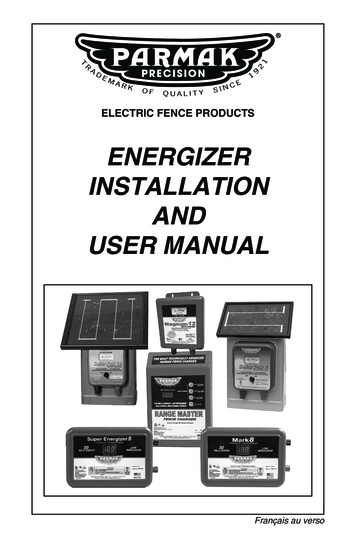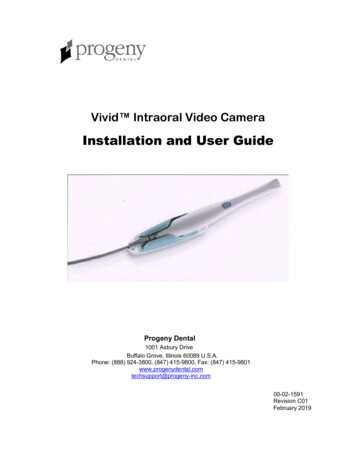
Transcription
ELECTRIC FENCE PRODUCTSENERGIZERINSTALLATIONANDUSER MANUALFrançais au verso
TABLE OF CONTENTSPAGEINTRODUCTION1HOW ELECTRIC FENCING WORKS1-2INSTALLING THE ELECTRIC FENCE SYSTEMI) INSTALLATION TIPSII) TYPICAL FENCE SET UPSIII) INSTALLING THE ENERGIZERIV) PARMAK SOLAR MODELS DF-SP-LI & MAG12-SP2-33-45-88-9TROUBLESHOOTING GUIDE9-10ELECTRIC FENCE MAINTENANCE10TYPICAL LAYOUT FOR ROTATIONAL GRAZING11PARMAK ENERGIZER PRODUCT LIST11-13RECOMMENDED GROUND RODS14-15IMPORTANT SAFETY TIPS15-16WARRANTY INFORMATION17(i)
WARNINGREAD ALL INSTRUCTIONSPARMAK ELECTRIC FENCE PRODUCTS PARMAK ENERGIZERS – USER/INSTALLATION MANUALCONGRATULATIONS!You have purchased one of the most advanced energizers in the world. Specially designedand specially selected state-of-the-art components are used in this energizer to provide unprecedented performance and reliability.We welcome your comments and suggestions. Our engineering department is continually reviewing new product concepts and new applications of our current products. Your input is avaluable guide to this research and development program, enabling us to bring you the equipment that best meets your changing needs.This manual is straight forward and thorough enough to answer most questions about installation and operation. READ THIS MANUAL COMPLETELY BEFORE YOU START TO INSTALL YOUR ELECTRIC FENCE SYSTEM. This manual covers installation of PARMAKelectric fence chargers including solar powered models. For further information, feel free tocontact either your dealer where you purchased this product or write to our customer servicedepartment at Parker McCrory Mfg. Co., 2000 Forest Ave, Kansas City, MO 64108 or visit ourwebsite at www.parmakusa.com.THE WARRANTY ON PARMAK ELECTRIC FENCE ENERGIZERS IS SET FORTH ON PAGE16 & 17.How Electric Fencing Works:The object of electric fencing is to keep your livestock inside their grazing area by giving theman electric shock when they contact the charged fence wire. Properly installed and groundedelectric fence is an effective, economical way to fence livestock. WARNING: Electric fence isa psychological barrier, not a physical barrier. It’s effectiveness depends on proper fence construction. Under certain circumstances livestock can escape the fenced area. Do not rely on aportable electric fence as the only means of keeping livestock out of areas that may cause injuryto themselves or people. Fence construction will vary depending on location of fence and typeof livestock being confined. Special attention to constructing fence should be given when fenceis located near roadways, railroad tracks, rivers, ponds, etc., to insure animals cannot escape thefenced area, which may cause injury to themselves or people. Constructing a temporary, portablefence is not recommended for these locations, a permanent physical barrier fence should be usedin these locations.The fence energizer must provide a high guard voltage on the charged wires to force the shockcurrent to jump from the wire to the animal’s skin. The fur, hair, or wool of the animal insulatesthe wire from the animal’s skin. A guard voltage of 5000 Volts will jump through about 1/8 inch(3mm) of hair. Domestic cattle can usually be managed with a guard voltage of approximately2000 Volts (horses and pigs can be managed with slightly lower guard voltages).The shock current travels through the body of the animal and into the earth ground where theyare standing. The effect of the shock on the animal depends on the amount of shock current,the duration of the shock, and the body weight of the animal.The shock current travels through the moist earth back to the ground rod and through thegrounding wire back to the energizer to complete the circuit. The amount of shock current is limited by all of the resistances of this electrical circuit including: the charged wire, theanimal’s body, the contact between the animal and earth ground, the earth ground, the contact between earth and the ground rod, and the ground rod wire back to the energizer.1
When grass and weeds grow up and touch the charged wires, current is leaked to the earth.The energizer automatically supplies this leakage current through the weed load and tries tomaintain an effective guard voltage on the charged wires. When this leakage current increasesbeyond the capacity of the energizer, the guard voltage decreases and the available shock current is no longer adequate.The larger the animal, the more shock current is required for it to feel an involuntary musclereaction. Horses tend to be more excitable than cattle and can be easily trained to respect anelectric fence. Since small animals are more sensitive, it is best to use a less powerful energizer that is capable of maintaining an adequate guard voltage on the fence.Wildlife management requires special considerations for fence design and energizer selection.Wild animals do not casually approach the fence while grazing like domestic animals do. Wildanimals see a fence as something to be jumped over or crawled under. The fence designshould entice the wild animal to crawl through the fence between charged wires. You need tohave a guard voltage of at least 5000V to jump through the animals hair on the very first contactwith the fence. It is necessary to keep grass and weeds away from the fence to increase thevisibility of the fence and to minimize the weed load losses.TRAIN STOCK TO RESPECT NEW FENCE INSTALLATIONProper training of stock is important. Remember, it is not the wire that holds them, but their fearof the shock they receive each time they touch the wire. Training is easy and quick.String a piece of wire, on insulators, across one section of barnyard about two-thirds heightof animals. Place some tempting feed on opposite side of wire. Allow stock to approach wireslowly so as to learn what gives them the sting. Then when they meet up with fence in field theywill know why to respect it. After one or two attempts to reach feed, stock will realize sting iscoming from wire, and they are ready to be turned out into field. Ten to twenty minutes is usuallytime enough to complete training period. A short length of electric fence installed on the farmwill make the stock think twice before touching any fence.If used for portable electric fencing, this productmust be used within permanent fencing. Itseffectiveness is dependent upon proper installation and electrification.Do not use portable electric fencing as only means of animal restraint. Ifused as only means of restraint without permanent fencing, animals mayescape with the risk of serious injury to animals or people.INSTALLING THE ELECTRIC FENCE SYSTEM:An electric fence system includes the energizer, fence wires, insulators, posts, and the groundrod system. The fence energizer stores energy from the power source (110-120 Volt AC, 6 Voltbattery, 12 Volt battery, or Solar panel) for about one second. The stored energy is then discharged to the fence in a very short pulse at a high voltage. If an animal is touching a chargedwire when the discharge occurs, the shock current will flow from the energizer, through the fencewire, through the animal to the earth ground, back through the moist earth to the ground rod, andback through the ground wire to the energizer to complete the circuit.The earth grounding system is the mostimportant variable in your electric fencesystem. The resistance of the contactbetween the animal and the earth, the resistance of the earth itself, and the resistance between the earth and the groundrod change dramatically from farm to farmand seasonally.FENCE ENERGIZER- CHARGED WIRE 10” GROUNDWIRE6’Min.10” 20”GROUND RODS10’10’MOIST SOIL210’10’
INSTALLATION TIPS:The fence materials and design must be suitable for electric fencing. Fence construction mustbe adequate to confine livestock in the fenced area. The fence wires must not touch eachother, metal posts, trees, or the earth. A perimeter fence around the farm must provide a permanent physical barrier. The wires may be charged to enhance the permanent fence or to runpower to other parts of the farm fence system.The height of the wire should be approximately 2/3rd the height of the animal. If there are different size animals within the field, there must be a charged wire at 2/3rd the height of eachsize of animal. Portable fence wires are often attached to plastic or fiber glass posts. If metalposts are used, then good quality insulators must be used to prevent the wires from shortingagainst the steel posts.TYPICAL FENCE SET-UPSSingle Wire Portable FenceA single wire portable fence may be used for pasture management. The single wire must be atapproximately the nose height of the animal. A single wire fence will not work reliably if thereare different sizes of animals in the pasture. Do not use single wire fence for boundary fence.PARMAK ENERGIZERGroundBlackOutputRedCharged WireGround RodMulti Wire Pasture Management FenceFor a pasture with different size animals, a multi-wire fence is required with a charged wire atthe nose height of each size animal. Connect similarly charged wires together every 1/4 mile(400m) to reduce the voltage loss from wire splices.PARMAK ENERGIZERGroundBlackOutputRedCharged WireCharged WireGround RodHorse FenceHorses are unpredictable and because of their ability to run and jump, horses can escapefenced pastures (especially when frightened). In locations where horses may escape causinginjury to themselves or people (ie. roadways, railroad tracks, rivers, etc), a permanent boundary fence must be constructed. In addition to the permanent fence, use Baygard 1 1/2” ElectricEqui-Tape (item #894) for increased visibility to help horse see and avoid fence. NOTE: Whenfencing horses no type of fence is totally escape proof. Maintain fence and check the fenceregularly.3
FENCE ENERGIZER- CHARGED WIRE 10”10”10”10”12” GROUND WIRE 6’Min.GROUND RODS10’10’MOIST SOIL10’10’Within the permanent boundary fence, separate your stock quickly and efficiently by using Baygard portable electric fence wire, tape, or 1/4” electric rope for cross fencing, paddock fencing,pasture management, etc. Do not use portable electric fence for boundary fence.SEPARATEYOURSTOCKDo not allowlivestockto become entangled inQUICKLYANDEFFICIENTLYelectricfencewire. Doing so will cause stressto animal and animal could cause serious injury or death to itself trying toescape fence. Do not use barbed wire or equivalent with electric fence.Ground Return FenceIn dry or frozen conditions you cannot rely on the earth ground to return the shock currentthrough the earth to the ground rod. A multi-wire fence with alternate wires charged andgrounded will work in these conditions. The animal must touch both a grounded and chargedwire to get a strong shock. If the animals are likely to reach under the bottom wire, it must beone of the charged wires. Use extra ground rods connected to the grounded wire every 1/4 mile(400m). The animals will then be 1/8 mile (200m) or less from a grounding location no matterwhere they are along the fence.PARMAK ENERGIZERGroundBlackOutputRedCharged WireGrounded WireCharged WireGround RodGround Rod4
Woven Wire FenceIf woven wire is dug into the ground, then connect the woven wire to the ground rod and run acharged wire above the woven wire and/or on the inside of the fence using insulators. Do notallow charged wire to contact the woven wire fence.PARMAK ENERGIZERGroundBlackGround RodCharged WireOutputRedInsulatedSpacerGrounded WireSIDEVIEWCheck local and state codes regarding theuse of electric fence. Some locations requirethe electric fence be identified with “Electric Fence Warning Signs”. UseParmak/Baygard warning signs item #2160.INSTALLING THE ENERGIZER110-120 VOLT AC ENERGIZERS:A 110-120 Volt AC operated energizer must be mounted indoors. The energizer must be protected from rain, snow, high humidity, and condensation. Energizer must be installed in clean,dry location. The energizer should be as close to the fence and ground rod as practical.IMPORTANT INFORMATION ABOUT YOUR FENCE CHARGERYour new AC powered fence charger is equipped with a digital voltage meter. The digitalmeter reads guard voltage on the fence in kilovolts (example: a reading of 3.5 3,500 volts, 8.9 8,900 volts, 14.7 14,700 volts).The reading of guard voltage will vary as fence condition changes (i.e. fence load). A guard voltage of 2.0 or higher indicates a good fence for most shorthairedanimals. A guard voltage of 4.0 or higher indicates a good fence for most long hairedanimals and predators.On a properly constructed, well-grounded fence of short length, it is normal to see a guard voltage reading in the mid teens. As additional charged wire is added to the fence, it is normal forthe indicated guard voltage to drop due to increased fence load.If the guard voltage reading drops below 2.0 the fence should be checked for shorts causedby grass, weeds, tree limb, etc., contacting fence, broken insulator causing short to fence post,poor ground, etc. Once the problem on the fence has been eliminated the guard voltage shouldreturn to a normal level.110-120 volt A.C. models are FOR INDOORUSE ONLY. NOT DESIGNED FOR OUTDOORUSE. SHOCK HAZARD MAY EXIST IF USED OUTDOORS.5
BATTERY ENERGIZERS:IMPORTANT! PARMAK model DF-LI-U.O. & Mag 12 U.O. battery operated energizers aremanufactured for outdoor use. Use battery in good condition. Use 6 volt battery with model DFLI-U.O. Use 12 volt wet cell lead acid battery minimum 80 A.H. rated with model Mag 12 U.O.Connect cable red lead ( ) to positive ( ) terminal of battery. Connect cable black lead (-) tonegative (-) terminal of battery.ALWAYS CONNECT NEGATIVE (-) LEADFIRST. THE SOLAR MODELS DF-SP-LI ANDMAG 12-SP ARE COMPLETELY WEATHERPROOF FOR OUTDOORINSTALLATION. SOLAR MODELS ARE SOLD COMPLETE WITHBATTERY AND BATTERY IS CONNECTED AT FACTORY.TO PREVENT A SHOCK HAZARD, DONOT OPERATE BATTERY OPERATEDENERGIZERS WHEN USING A BATTERY CHARGER. DISCONNECTAND REMOVE BATTERY WHEN RE-CHARGING IS NECESSARY.ENERGIZER TERMINAL CONNECTIONSUse corrosion resistant metal wire such as galvanized steel or aluminum wire 14 ga. (2.5 mm)or heavier to connect the energizer to the fence and ground rod. Connect the BLACK GROUNDterminal to the ground rod. Connect the RED FENCE terminal to the fence wire(s) beingcharged. If the energizer is inside a building, use insulated electric fence cable (under gate wire)for both connections. Where the wires go through the wall, additional insulating plastic bushingor porcelain bushings may be required to prevent damage to the cable from any sharp edges.COLOR CODED OUTPUT TERMINALS: Your fence charger has, color-coded output terminals. RED terminal to fence, BLACK terminal to ground.DO NOT OVERTIGHTEN OR USE PLIERS TO TIGHTEN TERMINALS!These terminals have a wire locking mechanism that will allow you to simply hand tighten theterminals and the wires will be secure. Damage to the terminals may occur if over tightened.Damage caused by over tightening is not covered under warranty. Do not allow either thecharged fence wire or the ground wire to contact the fence charger case.DO NOT CONNECT SIMULTANEOUSLY TO AFENCE AND TO ANY OTHER DEVICE SUCHAS A CATTLE TRAINER OR A POULTRY TRAINER. OTHERWISE,LIGHTNING STRIKING YOUR FENCE WILL BE CONDUCTED TO ALLOTHER DEVICES.INSTALLING THE GROUND ROD SYSTEM:The ground rod must be a corrosion resistant metal rod such as copper or galvanized steel,approximately 6’ to 8’ long. In order to determine that the ground rod is working satisfactorily,check the fence with a voltmeter on a regular basis. Use a voltmeter made for electric fencing. Ifone ground rod is not satisfactory, additional ground rods spaced 10’ (3m) apart and connectedin parallel may provide satisfactory grounding. Connect the ground terminal of the energizer tothe ground rod. For ground rod connections, always use corrosion resistant metal wire such asgalvanized steel or aluminum wire 14 ga. (2.5 mm) or heavier. Use corrosion resistant electricalclamps to join the wire to the ground rod.IMPORTANT! Proper grounding is essential to the effectiveness of an electric fence.IMPORTANT! Dry or frozen soil conditions can reduce or eliminate the effectiveness of thefence shock. Before using this electric fence, check to determine that there is a shock satisfactory for the purpose desired. This check must be performed with a voltmeter made for electricfencing.6
DANGERDO NOT USE A WELL, WATER PIPE, OR YOURPOWER SYSTEM GROUND AS A GROUND ROD.IF LIGHTNING WERE TO STRIKE THE FENCE, SOME OF THE LIGHTNINGCURRENT WILL RETURN THROUGH THE WATER OR ELECTRICALSYSTEM, CREATING AN EXTREMELY HAZARDOUS CONDITION.GROUNDING INSTRUCTIONS FOR AC POWERED ENERGIZERSThis energizer must be grounded. If the energizer should malfunction or break down, groundingreduces the risk of electric shock by providing a path of low resistance for the electric current. Someenergizers are equipped with a cord having an equipment grounding conductor and a 3 bladegrounding attachment plug. Others are equipped with a cord and a polarized 2 blade plug (oneblade wider than the other blade). Both are for use on a 120 Volt circuit.3 Blade Grounding Attachment PlugThe plug must be inserted into an appropriate outlet that is properly installed and grounded inaccordance with all local codes and ordinances.DANGERIMPROPER CONNECTION OF THE EQUIPMENTGROUNDING CONDUCTOR OR IMPROPERUSE OF THE PLUG CAN RESULT IN A DANGEROUS ELECTRIC SHOCK.CHECK WITH A QUALIFIED ELECTRICIAN OR SERVICE PERSONNEL IFYOU ARE IN DOUBT AS TO WHETHER THE CONTROLLER IS PROPERLYGROUNDED. DO NOT MODIFY THE PLUG PROVIDED WITH THECONTROLLER. IF IT WILL NOT FIT IN THE OUTLET, HAVE A PROPEROUTLET INSTALLED BY A QUALIFIED ELECTRICIAN.If repair or replacement of the cord or plug is necessary, do not connect the grounding wireto either flat blade terminal. The wire insulation having an outer surface that is green with orwithout yellow stripes is the grounding wire.This controller is for use on a nominal 120 V circuit and has a grounding plug that looks likethe plug illustrated in sketch A. A temporary adapter, which looks like the adapter illustrated insketches B and C, may be used to connect this plug to a 2 pole receptacle as shown in sketchB if a properly grounded outlet is not available. The temporary adapter should only be useduntil a properly grounded outlet (sketch A) can be installed by a qualified electrician. The greencolored rigid ear lug, or the like, extending from the adapter must be connected to a permanentground such as a properly grounded outlet box cover. Whenever the adapter is used, it mustbe held in place by a metal screw.GROUNDEDOUTLETADAPTERGROUNDEDOUTLET BOXGROUNDING PIN(A)(B)METALSCREWTAB FORGROUNDNG SCREW(C)2 Blade Polarized PlugThe plug must be inserted into an outlet that is properly installed in accordance with all localcodes and ordinances. The plug fits into the outlet only one way. If it fails to fit, turn the cordover. If it still does not fit, have a qualified electrician install the proper outlet.Grounding of this product is provided by a properly installed ground rod electrically connectedto the fence controller output ground terminal (as shown in the installation instructions, page 6).An internal fault on an improperly grounded fence controller could result in a risk of high electricshock currents on the electrified fence.7
DANGERDO NOT MODIFY THE PLUG PROVIDED WITH THECONTROLLER. IF IT WILL NOT FIT THE OUTLET,HAVE A PROPER OUTLET INSTALLED BY A QUALIFIED ELECTRICIAN.If it is necessary to use an extension cord, use a cord with a socket type that matches the plugpattern of your energizer’s service cord; 2 blade polarized, or 3 blade with a grounded conductor. Replace or repair a damaged cord.ADDITIONAL INSTRUCTIONS FOR PARMAK SOLAR MODELS DF-SP-LI & MAG12-SPSolar Energizer InstallationChoose a location that provides maximum exposure to the sun throughout the entire day. Position the energizer away from trees or buildings that could cast shadows on the solar panel.Hang the energizer off of the ground facing due south using the mounting holes on the backof the unit.Parmak solar fence chargers are shipped from the factory with a fully charged battery; however,due to the time from manufacturing date and retail sale, the battery may become discharged.The first time the energizer is used after purchase or after prolonged storage, place the energizer in the sun for 5 full SUNNY days with the switch in the off position to recharge the internal battery to a full charge. CLOUDY DAYS DO NOT COUNT FOR THE NEEDED 5 SUNNY DAYS.The battery can also be recharged by removing battery from battery case and recharging itwith a 6 or 12 volt taper charger (item #951 – 6 volt or #952 – 12 volt). The taper chargers areavailable from your local Parmak dealer. The taper charger will recharge the battery within 48to 72 hours.Solar Energizer OperationThe PARMAK Solar energizer’s solar panel converts sunlight into electric current to chargethe internal battery. The meter on the front of the unit indicates the unit operation and amountof voltage on the fence. The energizer will operate in cloudy or low light conditions. However,should low light conditions prevail for extended periods of time, this could cause the batterylevel to go extremely low. If this happens it is recommended that the energizer be turned off toallow the solar panel to recharge the battery in full sunlight for 5 sunny days or battery can beremoved from the energizer and recharged by using taper charger either item #951 (6 volt) oritem #952 (12 volt) depending on which model you own. With taper charger, recharge batterya minimum of 48 hours.INSTALLATIONLocation and Mounting of EnergizerAll indoor models must be installed in a CLEAN, DRY LOCATION where rain or snow cannotblow in on energizer. Milk house or other normally damp buildings are not recommended. Mountenergizer on wall with convenient mounting holes on back of energizer. DO NOT PLACE ENERGIZER ON FLOOR OR SHELF. See nameplate on front of energizer to determine whetheryou have an indoor or outdoor model.The outdoor, portable, weatherproof models may be installed anywhere. Mount energizer securely on wood or steel post by using a 10” 2x4 across post. If energizer is installed on sameside of fence as livestock, a charged wire may be stretched across the front of energizer to prevent stock from pushing energizer down. Do not allow charged wire to touch energizer case.Special Note - Solar ModelsThe solar powered models must be installed outdoors away from any trees or buildings. Face energizerand solar panel DUE SOUTH in the Northern Hemisphere (U.S.A.) or DUE NORTH in Southern Hemisphere. Mount so energizer cannot move. Mount where solar panel will be in direct sunlight the entireday. Solar panel is mounted on energizer at correct tilt angle to insure maximum year round energy collection efficiency. If solar panel becomes dirty, clean with water to maintain maximum energy collection.Under normal conditions rain, etc. will keep solar panel clean.8
NOTEReplace battery only with Parmak Powerhouserechargeable lead acid (Gel Cell) battery either item #901(6 volt) or item #902 (12 volt) depending on which model you own. Using anyother brand battery will reduce the performance of your solar powered fencer.HOW TO REPLACE BATTERYSOLAR PANELBATTERY CASELIDBATTERY CASESolar panel is riveted to battery case lid. The battery case lidis attached to the battery case by friction. Using a flat headscrewdriver lift battery case lid just above the raised ridgeof battery case. Carefully remove the battery case lid withsolar panel to expose battery inside battery case. There maybe cardboard packing inside the battery case used to keepthe battery from shifting during shipment. Replace cardboardafter installing new battery.Once the battery is installed, replace battery case lidsecurely by pressing down on the battery case lid. Makesure battery case lid is attached securely to the batterycase. Be careful not to pinch wires between the battery case and the battery case lid whenreplacing the battery case lid.TROUBLESHOOTING GUIDEThe best way to isolate a problem on an electric fence system is to follow the steps below:1) To test the energizer, disconnect it from the fence and measure between the ( ) POSITIVEand GROUND (-) terminals with an electric fence peak voltmeter designed for electric fencing (aregular voltmeter will be destroyed if you try to measure the fence output voltage). The voltageshould be about 5000 Volts or more for all models. If you do not have an electric fence peakvoltmeter, you can use a neon type fence tester and it should give a bright orange or blue flash ifthe energizer is working properly. If you do not have a fence tester, you can make a jumper froma piece of insulated wire and short across the output terminals. You should be able to draw anarc about 1/10 inch (2.5 mm) and will hear a sharp snap if the energizer is working properly.With the energizer connected to the fence, measure the voltage between the fence and groundterminal on the energizer. If the voltage is lower than 2000 Volts, then check out the following:a) There may be an accidental connection between charged and grounded wires on the fence.Make sure that all of the fence wires are isolated from each other and that only similarly chargedwires on multi-wire fences are connected together.b) There may be an accidental connection between a charged wire and earth ground. Makesure that extra ground rods installed along the fence line are only connected to the groundedwire, not a charged wire. Make sure that the charged wire is not touching metal posts or metalobjects sitting on the ground. Make sure that a charged wire does not go through the water ina stream or slough.c) Perhaps the grass and weed load on the charged wires is too much for the size energizeryou are using. Make sure that the charged wires are not attached to trees in order to preventshorting. You may need to remove grass and weeds from the fence line and/or use a higheroutput energizer. Minimize the load on the energizer by disconnecting sections of fence that arenot required to keep your cattle in.2) If the energizer output voltage measured at the energizer terminals is adequate but thevoltage measured after it is connected to the fence seems to be too low or if the guard voltageseems to reduce along the fence, then check the following:a) The ground rod may not be adequate or the earth around the ground rod may be too dryto conduct current properly. Move the ground rod to a place where the earth is moist all yearround. Add more ground rods and/or use a ground return wire on a multi-wire fence. To test ifyour ground rod is adequate, lean a bare metal rod (metal post) against the charged wire about9
100 ft (30 m) from the energizer to simulate a heavy weed load. Using an electric fence peakvoltmeter, measure the voltage between the ground rod and a wire probe pushed into the earthabout 6 ft (2 m) from the ground rod. If the measured voltage is more than 500 Volts, then youneed to add another ground rod. A second ground rod should be driven into the moist earth atleast 10 ft (3 m) from the first one and connected to the first ground rod. Repeat the test with thevoltmeter and add a third ground rod if necessary. If three ground rods still do not work, thenyou will have to consider changing your fence to a multi-wire type with one wire carrying theground return along the fence.b) The charged wire may be accidentally touching trees, or the wire may be contacting metalposts, or the wire may be contacting other wires that are grounded. In any of these cases, theguard voltage on the fence may reduce as you get closer to the location of the short circuit toground. Use insulators when using metal or wood fence posts.c) A charged wire may be laying on the ground or passing through water. Repair the fence anduse cutout switches to disconnect wires that are touching water.d) Charged and grounded wires of a multi-wire fence may be accidentally shorted together.Remember that it is the animal that completes the electrical circuit. DO NOT connect chargedand grounded wires together or the fence will be shorted!e) There may be loose or corroded splices in the charged wire(s) or the connection to theground rod may be corroded. Replace corroded wire and repair splices to ensure good electrical connections. Dissimilar metals may corrode. If connecting different wire types such as splicing portable electric fencing to permanent fencing, use a Baygard pulse connector item #676to ensure good contact.f) The resistance of the charged wire may be limiting the amount of current to the fence. Do not useportable electric fence wire to connect from the energizer to an electrified permanent fence.g) The resistance of portable electric fence wire is too high to operate with grass and weedstouching the wire. Remove all contact with grass and weeds from portable fence wires.TRAINING ANIMALS TO RESPECT ELECTRIC FENCINGAnimals should be trained to respect the fence by introducing them to it in a small area. It maybe helpful to bait the fence with feed. For example, aluminum foil and molasses can be usedto bait wildlife. Remember, the charged wire must be at the nose height of each size animalbeing trained.ELECTRIC FENCE MAINTENANCEElectric fencing is an economical, effective means of livestock management, but it does requireregular monitoring and servicing. Extremely heavily weeded fences will eventually overloadeven the most powerful fence energizer. Portable electric fence wire and fence tapes will notwork effectively when grass and weeds are touching the charged wires.TYPICAL SERVICING:1. Maintain adequate permanent boundary fencing.2. Remove all vegetation from electric fence line.3. Check electric fence on a regular basis with voltmeter made for electric fencing. Use Parmak voltage meter item #813 or i
WARNING READ ALL INSTRUCTIONS 1. When grass and weeds grow up and touch the charged wires, current is leaked to the earth. The energizer automatically supplies this leakage current through the weed load and tries to maintain an effective guard voltage










